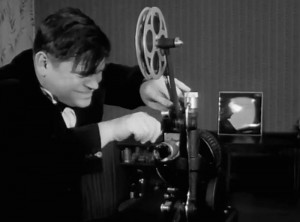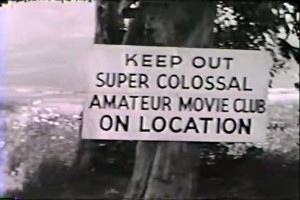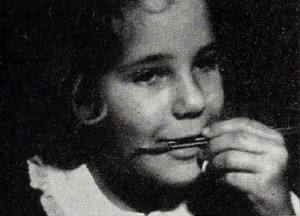"short abstract animation featuring visual rhythms created by the tempo and movement of circular, triangular, and square objects. Mori’s Senritsu was a black-and-white animation with synchronized music accompaniment, and Shimizu noted how the film attuned the visual images to the rhythm of the music, describing that “this kind of valuable experiment will inspire commercial talkies, more than Mickey Mouse and Silly Symphony do.” - Noriko Morisue, "Filming the Everyday: History, Theory, and Aesthetics of Amateur Cinema in Interwar and Wartime Japan" (Yale University: PhD Dissertation, 2020): 99.
"Film is a documentary on how to perform certain special effects in motion picture film. Film shows Toronto Movie Club members creating a double exposure, a humorous illusion, animation; shooting with a mirror and reversing motion" Archives of Ontario.

"Stop the Projector, I Want To Get Off features James Weatherburn as the bumbling projectionist who is trying to learn how to run one of the fool contraptions. His attempts are not quite all-out comedy, yet his antics are amusing, and anyone who remembers the day he first tried to run one of these complicated machines will be amused at someone else's interpretation of what the sensation is like" PSA Journal, Sept. 1966, 35.

"Amateur filmmaker, cinema historian and railway engineer H.A.V. Bulleid employs an array of camera effects and trick photography techniques in this experimental short. Bulleid uses a mirror to distort a woman's reflection and a lens mask to conjure multiple images of her within the same frame, followed by a brief sequence showing how it was created. A ghosting effect uses double exposure to show the woman getting up from the chair but leaving her body behind. Bulleid also uses coloured filters and gauze diffusion to alter the look of his shots, and slow motion to change their visual impact. To display the versatility of interior shooting under normal lighting conditions, Bulleid uses orthochromatic film stock, before returning to exterior effects, using greased disc diffusion to create a dreamlike wash over the image. The film concludes with two sequences created using trick photography techniques including film reversal and split-screen shooting, and an example of step-zooming which gradually zeros in on the Big Ben clock tower at the Houses of Parliament in London." (EAFA Database)

"Produced as a gift to Dorothy Burritt's husband, filmmaker Oscar Burritt (who was working in Toronto at the time), this is an offbeat study of life at their Vancouver apartment -- suite 2, 1960 Robson Street. The camera explores the apartment and the household memorabilia, and Dorothy is seen sitting for a portrait by painter Peter Bortkus. Later some friends drop by for a screening of Sacha Guitry's film Pearls of the Crown, followed by a party. Among the guests are Moira Armour, film editor Maureen Balfe, UBC student Stanley Fox, photographer Peter Varley, and an unnamed figure wearing a bird costume. Most of the people shown would have been involved with the National Film Society of Canada (Vancouver Branch). Suite Two won honourable mention (amateur category) at the first Canadian Film Awards in 1949." (BC Archives)
The film was restored in 1986 by the British Columbia Archives.

Comedic short film about an amateur movie club called Super Colossal Pictures.
"Film about a surprise party at the Woodley residence." Library and Archives Canada.

"Take a dozen or more normally exuberant youngsters in the second grade of school, mix them amid a day-long session of changing classes, and flavor with the excitement of making a movie — this was the recipe which Herbert F. Sturdy set himself to follow in cooking up Sweeter by the Dozen. He has been remarkably and quite charmingly successful. That the school was West Lake, in the svelte suburbs of Hollywood, and that the pupils were the progeny of "name" figures in the film colony, may have had, perhaps, something to do with it. But kids will be kids — whether in Glendale or Grand Rapids. By some alchemy of the camera, Mr. Sturdy has indeed made them sweeter by the dozen." Movie Makers, Dec. 1951, 412.
"All of the players in this picture were boys in a summer camp who upon discovering that one of their members has a movie camera decide to make a motion picture. Like all youth they decide to imitate and based their story on Tarzan. The producers of this worked up a splendid bit of comedy, interjected a fine piece of melodrama with an Alger Jr. finish that rounded it out into a production that many of the judges felt would have been worthy of showing in any theatre. The acting, direction, story and handling as a whole was considered equal to many a professional comedy." American Cinematographer, Dec. 1932, 7.
"An honorable mention in the 35 millimeter division went to Thomas Fisher, of 410 Semple Street, Pittsburgh, Pa., for his grim and Barrymorish study of Poe's 'The Tell-Tale Heart.' Mr. Fisher played two parts, displayed no little skill in make-up and worked out an interesting, if gory, film." Photoplay, Jun. 1928, 137.
Total Pages: 9